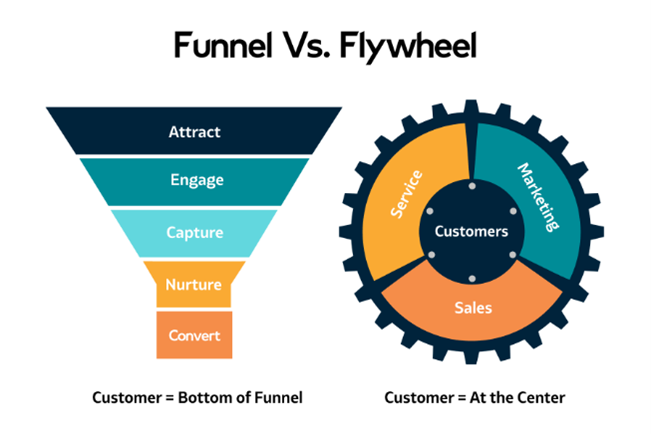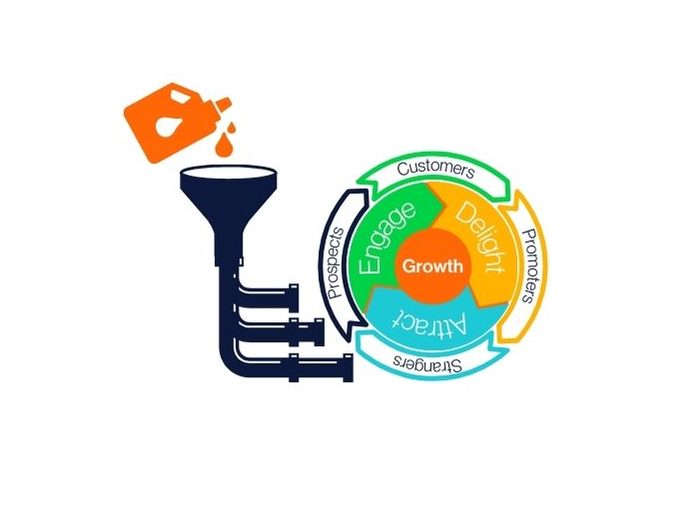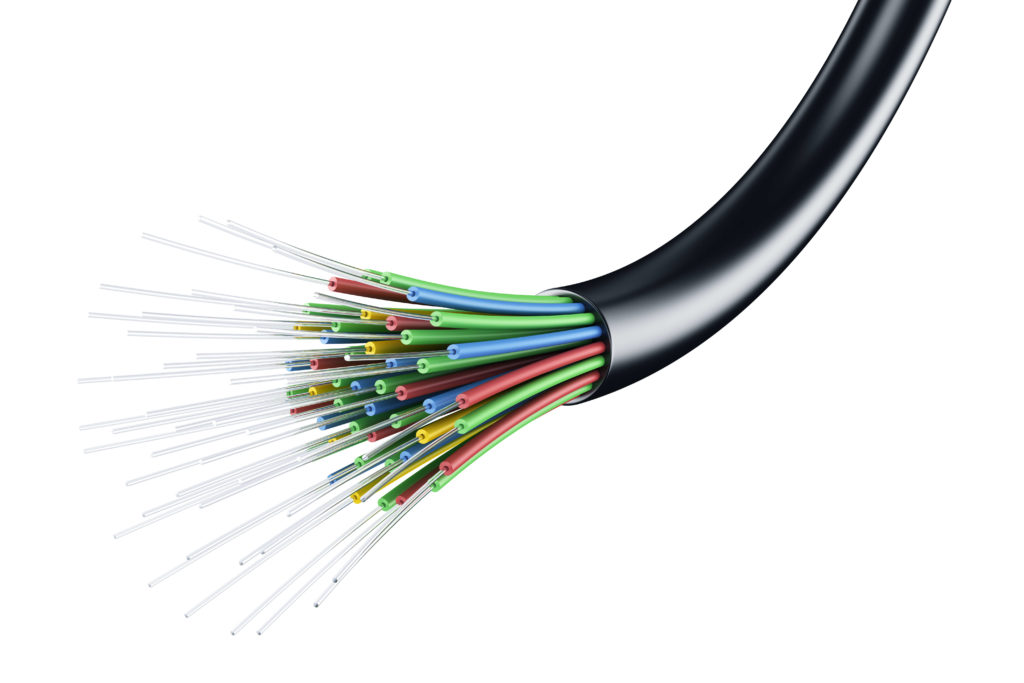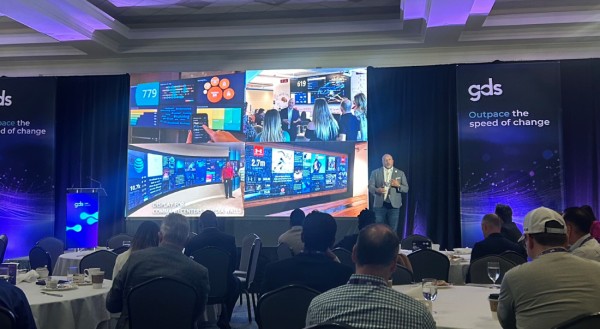Marketers are increasingly being asked to be a revenue generator for their business. How can we generate more leads? How can we convert more prospects? How can we attribute our contribution to deals won?
Sales no longer own the pipeline. Marketing has a big role to play. To grow marketing pipeline, marketers must align with sales and work together towards a common metric.
This comprehensive guide to mastering pipeline marketing looks at all of the elements that marketers need to consider; from sales and marketing alignment through to pipeline stage criteria and attribution modeling.
Table of contents:
What is pipeline marketing?
Pipeline marketing is a strategic approach that focuses on the entire funnel, rather than just the top (awareness) or the bottom (conversion). It aligns marketing and sales teams around a single revenue goal, tracking and optimizing every stage of the buyer’s journey to drive growth.
Instead of looking at just leads or just customers, pipeline marketing examines the continuum from prospect to customer, emphasizing the quality and progression of leads throughout the sales cycle.
Pipeline marketing is effectively an evolution in the way businesses approach the conversion process. By bridging the “traditional” gap that is felt between marketing and sales and focusing on the full journey of the customer, organizations can drive more meaningful engagements, conversions, and ultimately, revenue.
This strategy reshapes the marketing function, ensuring that every activity is aligned with the end goal of driving revenue.
So, how do you know if you are doing pipeline marketing?
- Is your marketing department a cost center?
- Is your marketing department a support function, not a revenue function?
- Does your marketing team have a different set of goals to your sales teams?
- Are you still using the marketing funnel approach to your activities?
If you answer ‘yes’ to any of these, then you’re not doing pipeline marketing, and this article is for you.
SMarketing and lead generation
Pipeline marketing does not involve marketing. Pipeline marketing does not involve sales. Hyperbole? A little. However, what is true, is that if marketing and sales are acting as individual silos then you cannot perform pipeline marketing. You need alignment.
Sales and marketing alignment, often termed as “SMarketing,” is a pivotal approach in contemporary business dynamics. Traditionally, sales and marketing operated in silos, each with its objectives, strategies, and metrics. However, as the landscape of business evolves with increased competition and informed consumers, the synergy between these two departments has become crucial, especially in the realm of lead generation.
Instead of marketing focusing on generating a high volume of leads and handing them off to sales, SMarketing emphasizes quality and readiness of these leads, ensuring that the leads being pursued by the sales team have a higher likelihood of conversion.
This alignment aids in creating a seamless transition for potential customers as they move from being a mere prospect, nurtured by marketing efforts, to being actively engaged by sales teams.
In the wider context of pipeline marketing, lead generation is one essential component. Pipeline marketing doesn’t view the customer journey in isolation but as a continuum.
Within this continuum, the harmonized efforts of sales and marketing play a crucial role. While lead generation is the initial step, ensuring that these leads progress through the pipeline – being nurtured, evaluated, and eventually converted – requires the collaborative strategies of both sales and marketing.
SMarketing enhances the entire flow and effectiveness of pipeline marketing, and at GDS, we’ve found that the best partners are the organizations that combine their SMarketing teams for event experiences, crafting a unified approach to engage potential clients from the initial touchpoint through to signed deal.
Moreover, we augment the SMarketing ecosystem with data-driven insights and analytics, ensuring that every step of the journey is informed, intentional, and yields measurable outcomes.
This convergence of innovative strategies, insightful data, and our signature event experiences ensures that the pipeline isn’t just a process but an ever evolving narrative of growth, innovation, and partnership.
The marketing funnel or the marketing flywheel?
The marketing funnel and the marketing flywheel are two well-known approaches to marketing strategy. Here are two very high-level summaries:
“The marketing funnel is a linear model that represents the customer’s journey in stages, from the first point of awareness to the final purchase decision. This model suggests that potential customers are ‘filtered’ as they progress through various stages of the journey, leading to a narrowed group that eventually converts.”
“Inspired by the mechanical flywheel which stores rotational energy, the marketing flywheel is a circular model emphasizing the continuous nature of the customer experience. It recognizes the momentum that can be generated when businesses focus on delighting customers even after the sale.”

Both have their merits and uses. They aren’t wrong. But pipeline marketing is more than a single model. Where the marketing funnel succeeds in creating clear steps and flows to creating a customer journey with succinct touchpoints, it lacks the holistic lifetime value of the customer (unless you stack funnel on top of funnel).
The marketing flywheel – by nature of being a wheel – is a far more rounded approach to modern marketing. It considers the customer journey as a cycle, where, the customer and lifetime value is at the core of your approach.
Pipeline marketing must consider both of these approaches. How does a potential customer move from the top of the funnel (TOFU) to the middle (MOFU) then the bottom (BOFU), but also how should this new customer be nurtured, to generate further sales, increased monthly recurring revenue (MRR) or annually recurring revenue (ARR).
The marketing funnel fuels the marketing flywheel
The integration of the marketing funnel and flywheel is essential for a holistic approach to attracting and retaining customers. The marketing funnel focuses on guiding potential customers through stages from awareness to conversion, while the flywheel emphasizes the continuous engagement and delight of existing customers, turning them into advocates.
TOFU activities are instrumental in both models. They initiate the customer’s journey by generating awareness and drawing prospects into the funnel. However, these activities also play a role in initiating the momentum of the marketing flywheel. The key is ensuring that from these initial stages, value and engagement are prioritized, laying the groundwork for ongoing relationships and loyalty.
Events and experiential marketing serve as practical examples of this integration. Such events provide platforms where awareness and engagement coalesce. Attendees are introduced to brands and products, fulfilling the TOFU objective. However, the engagement doesn’t end there; these platforms also foster community and networking, transitioning smoothly into the ongoing engagement ethos of the flywheel.
A well-strategized marketing approach sees the marketing funnel and flywheel not as separate entities but as complementary forces. The goal is not just lead generation and conversion but extending beyond to nurture these relationships, turning satisfied customers into brand advocates. This ensures a balanced focus on acquisition and retention, leading to a self-sustaining ecosystem of continuous growth and engagement.

Leaky buckets and solid pipelines
The “leaky bucket”. If you haven’t heard of it before, is an analogy that is frequently used in marketing and business to describe a situation where efforts to attract new customers or leads are undermined by the loss or churn of existing customers.
Essentially, you can envision your business or marketing pipeline as a bucket into which you’re pouring water (new leads or customers). If there are holes in the bucket (representing issues in customer retention or other stages in the customer journey), water leaks out, indicating the loss of these customers.
These leakages are potential clients who have left your marketing pipeline, and there is no guarantee that you can get them back in quickly- if at all.

Stages of the leaky marketing pipeline
Input: The water you pour into the pipeline represents all the leads or prospects you’re attracting through your marketing activities. This could be via content marketing, paid ads, social media campaigns, and more.
Pipeline capacity: The bucket’s capacity is symbolic of the total potential audience or market you can tap into. The goal is to ensure the bucket remains as full as possible, which would imply a thriving customer base and a robust pipeline.
Leakages: These represent inefficiencies, issues, or challenges at various stages of the pipeline. Leaks might be due to:
- Top of the Funnel: Poor lead quality, attracting prospects outside your target audience, or ineffective marketing messages.
- Middle of the Funnel: Inadequate lead nurturing, lack of engagement, or failing to address prospects’ needs or questions.
- Bottom of the Funnel: Hurdles in the conversion process, whether in pricing, payment, or a cumbersome sales process.
- Post-Purchase: Customer service issues, product dissatisfaction, or failing to engage and retain existing customers, leading to churn.
Fixing the Leaks: To optimize your pipeline, the aim is to identify and plug these leaks. This might involve refining marketing strategies, enhancing customer support, introducing loyalty programs, or simply improving the product or service.
Retention vs. Acquisition: The “leaky pipeline” emphasizes the importance of customer retention alongside acquisition. While acquiring new leads and customers is crucial, it can be more cost-effective and impactful to retain, and nurture leads and prospects within your existing pipeline.
If you’re constantly losing existing customers (leaks) while only focusing on acquiring new ones, you’ll find yourself in an endless, inefficient cycle.
In summary, the “leaky marketing pipeline” underscores the importance of a holistic approach, ensuring that as marketers work hard to attract and convert leads, equal attention is given to nurturing and retaining those leads to prevent them from “leaking out.” It’s about creating a balanced strategy that encompasses the entire customer lifecycle.
Pipeline Stage Criteria
You pipeline is unlikely to be a straight, linear path. There are different types of leads – all require a different nurture flow. A form submission is not equal to a blog subscriber. A downloader of content is not equal to an email subscriber. Each has their own path to take down the pipeline, and each will require a different nurture flow.
With that in mind, another way to view your marketing pipeline is a fiber optic cable.

The fiber optic depiction of a marketing pipeline is far less common than the “leaky bucket”. However, it is arguable a much better representation, if you think about the breakdown of the different nurture flows and marketing activities required to different leads at different times.
What does marketing look like at each stage of the pipeline?
There are two different approaches that could be taken here, mostly dependent on your individual organizational structure.

Neither of these are wrong. They are, however, in their current form not conducive to a SMarketing approach because it implies the stages aren’t linked and are mutually exclusive of each other.
The marketing pipeline and sales pipeline are the same. The same leads flow through, and therefore it is important we get the marketing messaging aligned with the sales conversations throughout the pipeline.
Marketing and sales are both trying to generate leads. You are competing for the same prospects. Yet, this is not a competition.
The messaging should be aligned. The campaigns should be integrated. The nurture flow should be seamless.
From an outside, generalistic perspective, it’s difficult to suggest the exact messaging, flows and sequences your individual organization requires to create a SMarketing pipeline.
However, there are questions you can ask, which will help you to understand the symbiotic relationship between sales, marketing and pipeline. These questions should be answered in tandem with the sales teams, and not in isolation from them.
We have broken these questions down into 10 distinct areas:

Understanding the target audience
- Who is our ideal customer?
- What are their primary pain points and needs?
- How do they typically research and make purchase decisions?
Clarifying messaging
- What are the key value propositions and differentiators of our product/service?
- Are there any discrepancies in how marketing and sales describe the product or its benefits?
- How can we ensure consistent messaging across all touchpoints?
Qualifying leads
- What criteria are marketing using to qualify leads before passing them to sales?
- What feedback does sales have about the quality of these leads?
- How can we refine our lead qualification process to ensure that sales are spending time with the most promising prospects?
Understanding content and collateral
- What content and resources does marketing provide to help nurture and educate leads?
- What additional content or tools does sales need during their interactions with prospects?
- Are there any gaps in the content that can be addressed to make the sales process smoother?
Feedback and communication
- How frequently are marketing and sales meeting to discuss performance, feedback, and strategies?
- What system or platform are we using to ensure transparent communication between teams?
- Are there any communication bottlenecks or barriers we need to address?
Training and onboarding
- Are new sales team members trained on the marketing strategies and vice versa?
- How can we ensure both teams are updated on product changes, market shifts, or new marketing campaigns?
Metrics and KPIs
- What metrics are we using to evaluate the performance of our sales/marketing pipeline?
- Are there shared KPIs (Key Performance Indicators) that both teams are working towards?
- How are successes celebrated, and how are challenges addressed?
Dealing with challenges
- What common obstacles or objections are sales encountering during their discussions with prospects?
- How can marketing provide support or resources to address these challenges?
- Are there feedback loops in place for sales to communicate these hurdles to marketing?
Understanding the full journey
- Are we clear on the end-to-end customer journey, from initial awareness to post-sale?
- How can we ensure a seamless handoff between marketing and sales during this journey?
- Are there opportunities to further nurture or upsell clients post-purchase, and how can marketing support these initiatives?
Looking ahead
- What are the future goals for both the marketing and sales teams?
- Are there any upcoming campaigns, product launches, or market expansions?
- How can both teams collaborate and prepare for these future endeavours?
By addressing these questions and fostering open communication between marketing and sales, organizations can streamline their pipeline, optimize lead conversion, and create a more cohesive and efficient approach to driving growth.
Activity Vs stage
While both marketing and sales stages are structured and defined, activities within these stages can vary in intensity and impact. It’s crucial to recognize that not all leads and activities are made equal. Some activities have the potential to transcend stages, influencing and impacting the entire marketing and sales cycle. Their effects are not confined to a specific stage but flow through the entire pipeline, fostering a more dynamic and flexible interaction with leads.
In the context of dynamic activities that cut across stages, consider event experiences, such as the ones we run at GDS. These event experiences are not confined to a single phase of the pipeline. They are designed to generate awareness, spark interest, facilitate consideration, and even influence the purchase decision. The multifaceted nature of such events demonstrates how certain activities can be pivotal touchpoints at various stages of both the marketing and sales pipeline.
GDS Group’s events underscore the concept that while leads move linearly through stages, the activities that engage them do not always follow this linear trajectory. An event can simultaneously serve the purpose of raising awareness, nurturing interest, facilitating direct interactions for consideration, and catalyze the intent to purchase. These events become ecosystems where leads can transition between being prospects to becoming actively engaged potential buyers.
In the web of activities vs stages, there’s a nuanced interplay where the fluidity of activities complements the structured progression of stages. This is where SMarketing truly comes to life. The alignment of sales and marketing is not just in the seamless handover of leads but in the orchestrated synergy of activities that are designed to resonate with leads throughout their journey.
Every touchpoint is not just a step forward in the lead’s journey but a multifaceted engagement that resonates, influences, and drives progression across the entire pipeline.
Pipeline marketing goals
As we touched upon in the section about SMarketing [link to section], lead generation is a critical element of pipeline marketing. However, the simple generation of leads is not enough to support a growing pipeline.
Good leads. Bad leads
As marketers we should be responsible for not just getting leads in, but also ensuring they are the right quality.
Lead Generation. Lead Qualification. Lead Engagement. Lead Nurturing. These might be seen as marketing buzzwords, but the reality is that the work marketers must put into each of these stages is vital to pipeline growth. And yet, they are just the beginning of the process. They are the funnel and not the flywheel.
So, we come to the questions you need to be asking of your marketing team, starting with quantitative questions to give you the base understanding before.
Quantitative questions:
- What is your MQL (marketing qualified lead) and SQL (sales qualified lead) to deal conversion rate?
- What is your CPL (cost per lead) and CPA (cost per acquisition)?
- What numbers do you need to hit target, over a given period of time?
- What is your average time from lead to sale?
- What is the LTV (lifetime value) of a new customer?
- How many leads are marketing generating Vs influencing?
Every business will require a slightly different set of questions, but illustratively, it is important that you are asking this of your marketing team to understand the impact of your pipeline marketing.
Later in this article, we will explore how we can create attribution models around pipeline marketing and explore some of the metrics that should be considered when analyzing pipeline success in a marketing context.
Example
Your goal is $1,000,000 in marketing generated revenue for the year.
Your average order value is $40,000 per year.
Therefore, you need to generate 25 sales to hit the target for the year.
You generate 1000 leads, but only 100 (10%) become MQLs and deemed of sufficient quality to be passed to sales. 50 of those then become SQLs as sales are able to turn into a qualified pipeline opportunity.
Your sales team would need a 50% conversion rate on all SQLs or 25% on all leads passed from marketing to sales.
In the context of this example; there is a 90% drop off from inbound lead to qualification, which could signal a low lead quality. Which would then change the questioning from a quantitative approach to the qualitative approach.
Qualitative questions:
- How do you improve lead quality?
- How do you reach the right people at the right time?
- How are you going to start or enhance a relevant conversation with a prospect?
- How do you know the lead state of readiness to buy, along with the ability to purchase?
- What are the typical RBOs (Reflex Business Objections) that your sales team receives from leads?
- What are the reasons a deal wasn’t qualified or didn’t convert? i.e., the reasons for a blown opportunity.
Using the same illustrative example above; you would seek to uncover the “What, Why and How”. What happened? Why did it? How can we alter the outcome?”
The what: 50% drop off from MQL to SQL.
The why: There was a discrepancy in the job roles that the sales teams were seeking, versus what marketing were providing.
The how: Realign qualification criteria and adjust campaign messaging/audience targeting.
This is a super simplistic example of setting your pipeline marketing goals based upon a yearly target. However, the principle of measurable pipeline targets, coupled with contextual questions can help you to form, adapt, and innovate your marketing activities.
Is my marketing pipeline generated or influenced?
Being able to ascertain not only whether your marketing activities have generated a lead or influenced it (and to what degree) through the pipeline.
In our marketing pipeline context: “Marketing Generated” provides a clear-cut metric of the immediate effectiveness of marketing campaigns. It helps businesses understand the direct ROI of specific initiatives.
Whereas “Marketing Influenced” recognizes the holistic impact of marketing. Given that buyers often interact with brands multiple times and through various channels before making a decision, this metric captures the collective value of all marketing efforts in moving a lead towards conversion.
Suppose a software company launches a new webinar on the benefits of its latest product. A potential customer who signs up for the webinar after seeing an advertisement on LinkedIn and has had no prior interaction with the company would be considered a “Marketing Generated” lead.
Now, let’s consider the same software company. A potential customer might have initially learned about the company through a colleague (a non-marketing interaction). Later, they read several blog posts on your website and attended an online course (marketing interactions). Even though the primary reason they entered the pipeline wasn’t a direct marketing initiative, marketing still influenced their journey. This lead would be considered “Marketing Influenced.”
Understanding the difference between “generated” and “influenced” leads is super important. However, not all influences are the same. Not all interactions should be weighted equally, and the timing of the interactions is also critical.
So, the question remains, how do we attribute and measure the level of marketing influence upon the pipeline?
Attribution modeling
Attribution modeling plays a critical role in decoding the impact of various marketing activities on the sales pipeline. In today’s complex digital landscape, potential customers often engage with a brand multiple times across different channels before making a purchase.
Attribution modeling helps businesses discern which touchpoints or interactions had the most significant influence on the customer’s journey, enabling them to allocate resources more effectively and refine their marketing strategies.
What can be learned from attribution modeling?

- Marketing budget allocation: which channels or touchpoints are most influential in driving conversions? Which are impacting revenue generation?
- Holistic view of the customer journey: Instead of seeing marketing efforts in isolation, attribution modeling provides a comprehensive view of the customer’s journey, helps businesses understand how various interactions build upon one another to drive a conversion.
- Optimize the marketing mix: Attribution helps pinpoint which marketing activities are most impactful, allowing businesses to fine-tune their marketing mix.
- Improve cross-channel synergy: In an omni-channel world, it’s essential to understand how different channels work together. Attribution modeling can reveal synergies, such as how a social media ad might lead to a search query, which subsequently results in a website visit and conversion.
- Enhance personalization and customization: By tracking which touchpoints resonate most with different segments of the audience, businesses can tailor their marketing messages and tactics to better align with the preferences and behaviors of their target market.
- Quantify marketing’s contribution to sales: Attribution modeling directly ties marketing activities to conversions in the sales pipeline. This quantification not only validates marketing’s efforts but also aids in bridging any communication or alignment gaps between marketing and sales teams.
- Future planning and forecasting: Armed with data about which marketing activities drive the most value, businesses can make informed decisions about future campaigns, product launches, or market entry strategies.
Attribution models
There is a wide array of models that can be used to assess the impact of marketing upon the pipeline. Below are some of the key models, a brief description, their implications for the marketing pipeline and graphical representation.
Single touch models
1) First Touch
Attributes 100% of the conversion value to the first interaction a lead had with your brand.
Implications for pipeline marketing: Provides insights into the top of the funnel activities and which channels or campaigns are most effective at initially capturing audience attention.

2) Lead-Conversion
Credits the interaction that specifically converted a visitor into a lead.
Implications for pipeline marketing: Helps in understanding which touchpoints are pivotal in transitioning a mere visitor into a potential customer, optimizing mid-funnel activities.

3) Last Touch
Assigns 100% of the conversion value to the last touchpoint before the conversion.
Implications for pipeline marketing: Offers clarity on the final interactions that drive conversions, helping in refining bottom-of-the-funnel strategies.

Assigns 100% of the conversion value to the last touchpoint before the conversion.
Implications for pipeline marketing: Offers clarity on the final interactions that drive conversions, helping in refining bottom-of-the-funnel strategies.
Multi-touch models
1) Linear
Distributes the conversion value equally across all touchpoints in the customer journey.
Implications for pipeline marketing: Provides a holistic view, emphasizing the importance of every interaction equally, which might be useful for brands with a consistent engagement approach.

2) Descending (Time Decay)
Gives increasing credit to touchpoints as they approach the conversion moment. The most recent interactions get the most credit.
Implications for pipeline marketing: Highlights the importance of touchpoints closer to the conversion, which can be crucial for campaigns focusing on urgent sales or limited-time offers.

3) U-Shaped
Allocates a significant portion of the credit to the first and last touchpoints, while distributing the rest equally among the middle interactions.
Implications for pipeline marketing: Emphasizes the value of initial interest and final decision stages, helping marketers balance top-of-the-funnel and bottom-of-the-funnel activities.

4) W-Shaped
Divides a major chunk of credit among three main interactions: the first touch, lead-conversion touch, and the last touch, with any remaining touchpoints receiving smaller equal shares.
Implications for pipeline marketing: Recognizes key pivotal moments in the customer’s journey, allowing marketers to focus on initial engagement, mid-funnel nurturing, and conversion strategies.

5) Full Path
This extends the W-shaped model by also incorporating post-sale interactions, distributing credit across the entire customer journey.
Implications for pipeline marketing: Emphasizes the importance of post-purchase engagement and brand loyalty, ensuring that marketing doesn’t stop once a sale is made and that the value of customer retention and advocacy is recognized.

Each attribution model offers a different perspective on the customer journey, with each illuminating specific touch-points.
For effective pipeline marketing, choosing the right attribution model—or more likely, a combination of models—allows marketers to allocate resources, optimize campaigns, and ultimately drive conversions and revenue more effectively.
Performance measurement & metrics
Now that we’ve clearly identified what pipeline marketing is and shown how it can positively generate a more holistic image of all your marketing activities, while also providing you with a wealth of actionable data upon which decisions can be made; we now need to wrap this up be understanding some of the key performance metrics.
Your attribution models will give you an indication of where to spend your time and resources to generate help influence your decisions, but the bottom line of pipeline marketing is… and should be; are we generating revenue?
The problem is that not all metrics are made equal. A bit like our influenced pipeline, a certain weighting needs to be applied to each performance metric. This helps us to not only understand the importance of the metrics to the overall marketing strategy, but also give data on a more tactical level, regarding specific channels or activities.
Primary, secondary and tertiary performance marketing metrics

Below we’ve split out the difference between primary, secondary and tertiary metrics, given some examples and – most importantly – contextualized them within pipeline marketing.
1. Primary metrics
These are the high-level, often direct measures of success. They’re closely tied to overarching business or marketing objectives and often reflect the most immediate and significant impact of your marketing activities.
Example metrics: Revenue generated, Customer Acquisition Cost (CAC), Lifetime Value (LTV), and overall Return on Investment (ROI).
In the context of pipeline marketing; primary metrics would gauge the direct output of your pipeline efforts. For instance, tracking the revenue generated from leads that progressed through the marketing pipeline would be a primary metric. It gives you an instant view of how effective your pipeline marketing is in terms of the bottom line.
2. Secondary metrics
These metrics dive deeper and provide context to primary metrics. They help in understanding the underlying factors influencing primary metrics and may point to areas of improvement or optimization.
Example metrics: Lead conversion rate, average time taken to convert leads, Customer Retention Rate, and Churn Rate.
In the context of pipeline marketing; if you’re analyzing the efficacy of your pipeline, secondary metrics can reveal stages where leads may be stalling or dropping off. For example, if the lead conversion rate is low, it suggests that while you’re drawing people into the pipeline, there’s an obstacle to converting them to customers.
3. Tertiary metrics
These are the granular metrics that offer detailed insights into specific areas, channels, or tactics. They can be seen as diagnostic metrics that can help fine-tune strategies.
Example metrics: Email open rates, click-through rates, specific channel traffic (like from social media or PPC ads), page bounce rates, and engagement metrics on content pieces.
In the context of pipeline marketing; tertiary metrics offer insights into the practical details of individual campaigns or tactics within the broader pipeline. If a particular content piece has high engagement rates, it might be leveraged more prominently in nurturing leads. Alternatively, if PPC ads have a high bounce rate, they might need to be re-evaluated or optimized.
Utilizing these metrics in pipeline marketing
When managing pipeline marketing, begin with your primary metrics to get a holistic sense of performance. Are you achieving the revenue goals? What is the ROI of the activity?
This gives a top-level view of success, but ensure you continue to break it down into short, medium and long-term revenue. Because as mentioned earlier, some of these activities could be fueling your marketing pipeline for a long time, generating loyal customers and increasing their lifetime value to you.
Next, leverage secondary metrics to diagnose where in the pipeline there might be issues or opportunities for enhancement. Are leads getting stuck in the consideration phase? Are they churning soon after conversion? How long is it taken a lead to move from one lifecycle stage to another?
Finally, dive into tertiary metrics to refine individual tactics. Adjust email subject lines based on open rates, or revisit content strategies if engagement is lacking on certain pieces.
Together, these layers of metrics provide a comprehensive view of your pipeline marketing efforts, ensuring you’re both achieving macro goals and continually optimizing the micro elements of your strategy.
Conclusion
Mastering pipeline marketing is central to ensuring efficient lead conversion and fostering alignment between marketing and sales activities. At the core lies a clear understanding of the prospective customer’s journey, from the initial awareness phase in the marketing funnel to the final closing in the sales pipeline.
Marketers must first recognize the distinction between these two pipelines and integrate them into a single “fiber-optic” pipeline.
The old-hat approach is that the marketing pipeline revolves around stages like awareness, interest, and consideration, aiming to nurture leads until they are sales-ready. Then the sales pipeline takes over from lead generation to close, focusing on qualifying and converting these leads.
These pipelines are not mutually exclusive – marketing generates; marketing influences; and marketing helps convert the pipeline.
To optimize pipeline marketing, marketers should employ a robust mix of strategies, from understanding their target audience’s pain points to ensuring consistent messaging across all touchpoints. Effective attribution modeling, ranging from first-touch to multi-touch models like the U-shaped or W-shaped approach, can offer insights into which marketing activities are driving conversions.
Regular reviews, feedback loops, and the proactive plugging of “leaks” or inefficiencies in the pipeline, akin to fixing a “leaky bucket,” further enhance the pipeline’s performance.
Additionally, consistent communication with the sales team, underpinned by shared KPIs and feedback mechanisms, can ensure alignment and streamline the transition of leads from marketing to sales, creating a seamless and efficient conversion process.
At GDS, we are a firm believer in the power of event experiences to drive new pipeline. Whether digital summits, in-person events or selective roundtables, events are an opportunity for sales and marketing teams to align and generate leads.
Now it’s time to master your marketing pipeline.













